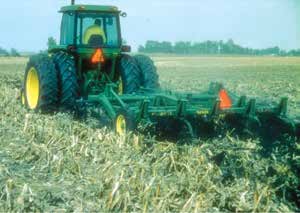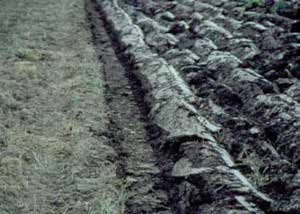chAPter 16 reduCing tillage
Table 16.1
Tillage System Benefits and Limitations
Tillage System
Benefits
Limitations
Full-Field Tillage
Leaves soil bare.
Allows easy incorporation of
Destroys natural aggregation and
fertilizers and amendments.
enhances organic matter loss.
Moldboard plow
Buries surface weed seeds.
Commonly leads to surface
Allows soil to dry out fast.
crusting and accelerated erosion.
Temporarily reduces compaction.
Causes plow pans.
Requires high energy use.
Same as above, but less aggressively
Chisel plow
Same as above, but leaves some surface
destroys soil structure; leads to
residues.
less erosion, less crusting, no
plow pans; requires less energy use.
Disk harrow
Same as above.
Same as above.
Restricted Tillage
Leaves little soil disturbance.
Makes it more difficult to incorporate
Requires few trips over field.
fertilizers and amendments.
No-till
Requires low energy use.
Makes wet soils dry and
Provides the most surface residue
warm up slowly in spring.
cover and erosion protection.
Can’t al eviate compaction.
Zone-till
Same as above.
Same as above, but compaction is al eviated.
Allows easy incorporation of
fertilizers and amendments.
Is hard to use with sod-type or
narrow-row crop in rotation.
Ridge-till
Provides some weed control
as ridges are built.
Requires wheel spacing to be
Allows seed zone on ridge to
adjusted to travel between ridges.
dry and warm more quickly.
TIllAgE SYSTEMS
erosion potential, it also is affected by factors such as
Tillage systems are often classified by the amount of sur-
surface roughness and soil loosening.
face residue left on the soil surface. Conservation tillage
Another distinction of tillage systems is whether they
systems leave more than 30% of the soil surface covered
are full-field systems or restricted systems. The benefits
with crop residue. This amount of surface residue cover
and limitations of various tillage systems are compared
is considered to be at a level where erosion is significantly
in table 16.1.
reduced (see figure 16.2). Of course, this residue cover
partially depends on the amount and quality of residue
Conventional Tillage
left after harvest, which may vary greatly among crops
A full-field system manages the soil uniformly across the
and harvest method (corn harvested for grain or silage is
entire field surface. Such conventional tillage systems
one example). Although residue cover greatly influences
typically involve a primary pass with a heavy tillage tool
176
Building SoilS for Better CropS: SuStainaBle Soil ManageMent







